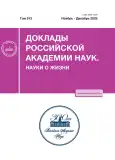CONTENT OF 13С AND 15N ISOTOPS IN BONE COLLAGEN OF GEOGRAPHICAL, AGE AND SEX GROUPS OF THE URAL CAVE BEAR (MAMMALIA, CARNIVORA, URSIDAE, URSUS (SPELAEARCTOS) KANIVETZ VERESTCHAGIN, 1973)
- Авторлар: Kosintsev P.A.1, Konovalova K.Y.1, Simonova G.V.2
-
Мекемелер:
- Institute of Plant and Animal Ecology, Ural Branch, Russian Academy of Sciences
- Institute of Monitoring of Climatic and Ecological Systems Siberian Branch Russian Academy of Sciences
- Шығарылым: Том 513, № 1 (2023)
- Беттер: 539-543
- Бөлім: Articles
- URL: https://journals.rcsi.science/2686-7389/article/view/244361
- DOI: https://doi.org/10.31857/S2686738923600565
- EDN: https://elibrary.ru/HRRPRQ
- ID: 244361
Дәйексөз келтіру
Толық мәтін
Аннотация
Data on the content of δ13C and δ15N isotopes in the collagen of bones of the Ural cave bear (Ursus (S.) kanivetz Verestchagin, 1973) from the Northern and Middle Urals were analyzed. The bones date from the first half of MIS 3. The bones of newborn individuals, individuals at the age of 1 year, males and females at the age of 2 years, 3 years, 4 years and older than 4 years were studied. Differences in δ13С values between age, sex, and geographical samples are not significant. With age, the value of δ15N significantly decreases, which is associated with the transition from milk nutrition to independent nutrition. The proportion of meat food in the diet of adult bears in the Middle Urals was higher than in the diet of adult bears in the Northern Urals. There are no noticeable differences in isotope signatures between males and females of different ages. The large cave bears of the Urals and Europe had a similar type of diet.
Негізгі сөздер
Авторлар туралы
P. Kosintsev
Institute of Plant and Animal Ecology, Ural Branch, Russian Academy of Sciences
Хат алмасуға жауапты Автор.
Email: kpa@ipae.uran.ru
Russian Federation, Yekaterinburg
K. Konovalova
Institute of Plant and Animal Ecology, Ural Branch, Russian Academy of Sciences
Email: kpa@ipae.uran.ru
Russian Federation, Yekaterinburg
G. Simonova
Institute of Monitoring of Climatic and Ecological Systems Siberian Branch Russian Academy of Sciences
Email: kpa@ipae.uran.ru
Russian Federation,
Tomsk
Әдебиет тізімі
- Bocherens H. Isotopic insights on cave bear palaeodiet // Historical Biology. 2019. V. 31. № 4. P. 410–421.
- Robu M., Fortin J.K., Richards M.P., et al. Isotopic evidence for dietary flexibility among European Late Pleistocene cave bears (Ursus spelaeus) // Canadian Journal of Zoology. 2013. V. 91. № 4. P. 227–234.
- Bocherens H., Stiller M., Hobson K.A., et al. Niche partitioning between two sympatric genetically distinct cave bears (Ursus spelaeus and Ursus ingressus) and brown bear (Ursus arctos) from Austria: Isotopic evidence from fossil bones // Quaternary International. 2011. V. 245. № 2. P. 238–248.
- Bon C., Berthonaud V., Fosse P., et al. Low regional diversity of late cave bears mitochondrial DNA at the time of Chauvet Aurignacian paintings // Journal of Archaeological Science. 2011. V. 38. № 8. P. 1886–1895.
- Pérez-Rama M., Fernández-Mosquera D., Grandal-d’Anglade A. Recognizing Growth Patterns and Maternal Strategies in Extinct Species Using Stable Isotopes: The Case of the Cave Bear Ursus spelaeus ROSENMÜLLER // Quaternary International. 2011. V. 245. № 2. P. 302–306.
- Münzel S.C., Stiller M., Hofreiter M., et al. Pleistocene Bears in the Swabian Jura (Germany): Genetic replacement, ecological displacement, extinctions and survival // Quaternary International. 2011. V. 245. № 2. P. 225–237.
- Nejman L., Wood R., Wright D., et al. Hominid Visitation of the Moravian Karst during the Middle-Upper Paleolithic Transition: New Results from Pod Hradem Cave (Czech Republic) // Journal of Human Evolution. 2017. V. 108. P. 131–146.
- Косинцев П.А., Симонова Г.В., Коновалова К.Ю. Первые данные о питании уральского пещерного медведя (Mammalia, Carnivora, Ursidae, Ursus (spelaearctos) kanivetz Verestchagin, 1973) по результатам анализа изотопов 13С и 15N // Доклады Российской академии наук. Науки о жизни. 2023. Т. 510. № 1. С. 288–291.
- Гимранов Д.О., Косинцев П.А. Пещерные медведи (Ursus spelaeus sensu lato) Урала // Палеонтологический журнал. 2022. № 1. С. 97–106.
- Rabeder G., Hofreiter M., Nagel D., et al. New taxa of alpine cave bears (Ursidae, Carnivora) // Cahiers scientifiques-Museum d’histoire naturelle de Lyon. 2004. V. 2. P. 49–68.
- Barlow A., Paijmans J.L.A., Federica A., et al. Middle Pleistocene genome calibrates a revised evolutionary history of extinct cave bears // Current Biology. 2021. V. 31. № 8. P. 1771–1779.
- Гуслицер Б.И., Канивец В.И. Пещеры печорского Урала. М.– Л. Наука, 1965.
- Барышников Г.Ф. Семейство медвежьих (Carnivora, Ursidae). СПб.: Наука, 2007. 542 с.
- Воробьев А.А. Размеры длинных трубчатых костей большого пещерного медведя Среднего Урала // Современные проблемы популяционной, исторической и прикладной экологии: Материалы конференции. молодых ученых; 23–27 апреля 2001. Екатеринбург: “Екатеринбург”; 2001. С. 38–41.
- Воробьев А.А. Этапы постнатального онтогенеза скелета большого пещерного медведя // Биота горных территорий: История и соврем. состояние: Материалы конференции молодых ученых; 15-19 апреля 2002 г. Екатеринбург: Академкнига; 2002. С. 22–28.
- Косинцев П.А., Воробьев А.А. Биология большого пещерного медведя (Ursus spelaeus Ros. et Hein.) на Урале. Ю.А. Розанов (ред.). В кн.: Мамонт и его окружение: 200 лет изучения. М.: Геос; 2001. С. 266–278.
- Fosse P., Cregut-Bonnoure E. Ontogeny/growth of (sub)modern brown bear (Ursus arctos) skeleton: A guideline to appraise seasonality for cave bear (Ursus spelaeus) sites? // Quaternary International. 2014. V. 339–340. P. 275–288.
- Liden K., Angerbjorn A. Dietary change and stable isotopes: a model of growth and dormancy in cave bears. Proceedings of the Royal Society: Biological Sciences. 1999. V. 266. P.1779–1783.
- Chisholm B.S. Variation in Diet Reconstructions Based on Stable Carbon Isotopic Evidence // The Chemistry of Prehistoric Human Bone. Cambridge: Cambridge Univ. Press, 1989. P. 10–37.
- Bocherens H., Drucker D. Trophic level isotopic enrichment of carbon and nitrogen in bone collagen: case studies from recent and ancient terrestrial ecosystems // Inter-national J. of Osteoarchaeol. 2003. V. 13. № 1–2. P. 46–53.
Қосымша файлдар










